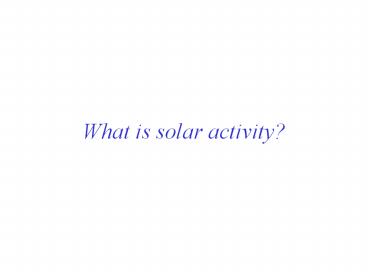What is solar activity? - PowerPoint PPT Presentation
Title:
What is solar activity?
Description:
Loops of bright gas (along magnetic field lines) connect ... Coronal mass ejections send bursts of energetic charged particles out through the solar system ... – PowerPoint PPT presentation
Number of Views:21
Avg rating:3.0/5.0
Title: What is solar activity?
1
What is solar activity?
2
Solar activity is like weather
- Sunspots
- Solar Flares
- Solar Prominences
- All related to magnetic fields
3
Sunspots Are cooler than other parts of the
Suns surface (4000 K) Are regions with strong
magnetic fields
4
Charged particles spiral along magnetic field
lines.
5
(No Transcript)
6
(No Transcript)
7
Magnetic fields store energy. Fields can change
their configuration and release that energy.
When they do, solar flares erupt, sending
bursts of X-rays and charged particles into space.
8
Corona appears bright in X-ray photos in places
where magnetic fields trap hot gas
9
How does solar activity affect humans?
10
Coronal mass ejections send bursts of energetic
charged particles out through the solar system
11
Charged particles streaming from Sun can disrupt
electrical power grid and can disable
communications satellites
12
Energetic particles high in Earths atmosphere
cause auroras (Northern Lights aurora borealis
and Southern Lights aurora australis)
13
How does solar activity vary with time?
14
(No Transcript)
15
Sunspot cycle caused by the winding and twisting
of Suns magnetic field, but the details are not
well understood
16
What have we learned?
- What causes solar activity?
- Convection combined with the rotation pattern of
the Sunfaster at the equator than at the
polescauses solar activity because these gas
motions stretch and twist the Suns magnetic
field.
17
What have we learned?
- How does solar activity affect humans?
- Bursts of charged particles ejected from the Sun
during periods of high solar activity can hamper
radio communications,disrupt electrical power
generation,and damage orbiting satellites.
18
What have we learned?
- How does solar activity vary with time?
- The sunspot cycle, or the variation in the number
of sunspots on the Suns surface,has an average
period of 11 years.The magnetic field flip-flops
every 11 years or so, resulting in a 22-year
magnetic cycle.
19
In-class activity
- Activity 27 Sunspots (pages 99-102)
- Do all parts of questions 1-5. Then well answer
some clicker questions on them.
20
5D. It is rare to find a sunspot above or below a
latitude of
- 5 degrees north or south
- 5 degrees north / 45 degrees south
- 45 degrees north / 5 degrees south
- 45 degrees north or south
- None of the above
21
Why do sunspots appear dark in pictures of the
Sun?
- They are holes in the solar surface which let us
see deeper, darker layers of the Sun. - They are thick clouds of cool gas which block the
light from underneath. - They are too cold to emit any visible light.
- None of the above.
22
What powers the sun?
- The fission of hydrogen into helium, which
converts some mass into energy - The fission of helium into hydrogen, which
converts some mass into energy - The complete conversion of the mass of some
hydrogen into energy - The fusion of hydrogen into helium, which
converts some mass into energy































